- Home
- Douglas Adams
Last Chance to See Page 9
Last Chance to See Read online
Page 9
The silverback seemed at last to tire of our presence. He hauled himself to his feet and lumbered easily off into another part of his home.
On the way back to the but I discovered that I had a small tin of tuna in my camera bag, so we greedily devoured this on our return, along with a bottle of beer, and that, at two o'clock in the afternoon, marked the end of fun for the day, unless you count listening to a couple of German, sorry, Latvian students explaining how good their penknives are as fun.
At this Mark started to get quietly ratty, which meant that he grasped the beer bottle very tightly between his hands and stared at it a lot. Kurt asked us what we were planning to do next and we said we were flying up to Garamba National Park to see if we could find any northern white rhinos. Kurt nodded and said that himself he thought he would probably walk to Uganda tonight.
Mark's knuckles grew whiter round his beer bottle. Mark, like most zoologists, tends to prefer animals, to people anyway, but in this case I was with him all the way. It occurred to me that we had spent a day rapt with wonder watching the mountain gorilla, and being particularly moved at how human they seemed, and finding this to be one of their most engaging and fascinating features. To find afterwards that a couple of hours spent with actual humans was merely irritating and a bit confusing.
Three days later I found myself standing on top of a termite hill staring at another termite hill through binoculars.
I knew that what I was standing on was a termite hill, but was disappointed that the thing I was staring at was not a northern white rhinoceros, since we had been walking determinedly towards it for upwards of an hour in the blazing midday sun in the middle of what can only be described as Africa.
Also we had run out of water. I could scarcely believe, having been brought up on a rich diet of H. Rider Haggard, Noel Coward and the Eagle, that the first thing I would do on encountering the actual real savannah plains of Africa would be to march straight out into them in the midday sun and run out of water.
Though I wouldn't admit it, of course, having been brought up on a rich diet of H. Rider Haggard, etc., I was actually a bit frightened. The point about not running out of water in the middle of the savannah is that you do actually need the stuff. Your body regularly mentions to you that you need it, and after a while becomes quite strident on the subject. Furthermore we were miles from anywhere, and though there were a number of theories flying around about where we'd left the Landrover, none of them so far had stood up to rigorous testing.
I don't know how worried Mark or Chris were at this point, because it was difficult to get them - particularly Chris - to say anything coherent. Chris is from Glasgow, and is an excellent specimen of one of the northern races: fair-haired and fair-skinned, never happier than when carrying a DAT recorder and a microphone wrapped up in something that looks like a large dead rabbit across the Scottish moors with the wind and rain lashing at his gritted teeth. He is not a natural for the savannah. He was walking by now in smaller and smaller circles and discussing less and less sensible things while glowing like a traffic light. Mark was getting red and sullen.
The two women with us thought we were complete wimps. They were Kes Hillman-Smith, a rhino expert, and Annette Lanjouw, a chimpanzee expert.
Kes Hillman-Smith took over from me on the termite hill and scanned the horizon. Kes is in fact one of the world's leading experts on northern white rhinos, but she was not a world authority on where in a national park the size of Scotland, the twenty-two surviving white rhino were to be found at that precise moment.
I may have got my facts wrong. I seem to have conflicting information on the size of Garamba National Park. One opinion is that it is only 5,000 square kilometres, in which case I would have to say that it was only the size of part of Scotland, but it was a big enough part for twenty-two rhinoceroses to be very effectively hidden in.
Kes had been very sceptical about the termite hill from the outset, as it would befit a world expert on rhinoceroses to be, but since it had been the only thing in the distant heat haze that looked even remotely like a rhino, and we had come all this way, she had suggested that we might as well go for it.
Kes is a formidable woman, who looks as if she has just walked off the screen of a slightly naughty adventure movie: lean, fit, strikingly beautiful, and usually dressed in old combat gear that's had a number of its buttons shot off. She decided it was time to be businesslike about the map, which was a fairly rough representation of a fairly rough landscape. She worked out once and for all where the Landrover had to be, and worked it out with such ruthless determination that the Landrover would hardly dare not to be there, and eventually, of course, after miles of trekking, it was exactly there, hiding behind a bush with a thermos of tea wedged behind the seat.
Once we had revived ourselves with the sort of mug of tea which makes the desert bloom and angels sing, we rattled and rolled our way back to our base, which was a small visitors' village of huts on the edge of Garamba National Park, separated from it by a small river. We were currently the only visitors to the park which, as I say, is the size of part of Scotland. This is quite surprising because the park is one of Africa's richest. It is situated in north-east Zaire, on the border with Sudan, and takes its name from the Garamba river which meanders from east to west through the park. Its habitat is a combination of savannah, gallery forest and papyrus marshes and contains currently 53,000 buffalo, 5,000 elephants, 3,000 hippos, 175 Congo giraffes, 270 species of birds, 60 odd lion and some giant eland, which are large, spiral-horned antelopes. They know there are giant eland in the park because we saw one. The last time anybody saw one there was in the nineteen-fifties. We were rather pleased about that.
The park is very scantily visited, partly, I imagine, because of the insane bureaucratic nightmares which assail any visitor to Zaire, but also because the park is three days' overland journey from Bunia, the nearest airport, so only the most determined visitors actually make it.
We were lucky. The Senior Management Adviser on the Garamba Rehabilitation Project, Charles Mackie, came to pick us up from Bunia in an anti-poaching patrol Cessna 185. The runway on which we landed just outside the boundaries of the park was merely a flattened piece of grass along which we bounded and hopped before finally slewing to halt. It was a dramatic change from the cold mistiness of the Virunga volcanoes - grassland as far as the horizon in every direction, hot, dry air, a Landrover bounding along dusty roads through the savannah, and elephants heaving themselves along in the hazy distance.
That evening we went to have a meal at the house which Kes shares with her husband Fraser, a park conservation manager. It was a house they built themselves, out in the bush on the edge of the river. The house is a long, low, rambling structure, full of books, and largely open to the weather - when it rains they lower tarpaulins over the spaces where the windows aren't. For the two years it took them to build the house they lived in a tiny mud but with a pet mongoose that used to dig up the floor looking for worms, a dog, two cats - and a baby.
Because their house is so open, it is regularly full of animals. A young hippo, for instance, frequently comes to chew on the pot plants in their living room. It often spends the night asleep in their bedroom with its head resting next to the (second) baby's cot. There are snakes and elephants in the garden, rats which eat all their soap, and termites gradually nibbling away at the support poles of the house.
The only animals that really worry them are the crocodiles, which live in the river at the bottom of the garden. Their dog was eaten by one.
'it is a bit of a worry,' Kes told us. 'But we just have to make our lives as comfortable as possible under the circumstances. If we lived in the city we'd be just as concerned about the children getting run over by a bus or abducted as we are about them being attacked by a crocodile.'
After dinner they said that if we wanted to stand a hope in hell of actually seeing any rhino then it would help considerably if we could find out where they actually were. They suggested that we ask Charles to take us up in the Cessna the next day, and then perhaps we could go out by Landrover again the day after that and see how close we could get to them. They contacted Charles over their battered old field radio, and made the arrangements.
Charles flies his plane the same way my mother drives her car round the country lanes in Dorset. If you didn't know she had done it invincibly every day of her life for years you would be hiding in the footwell gibbering with fear instead of just smiling glassily and humming `Abide With Me'.
Charles is a thin and slightly intense man, and also rather shy. Sometimes you think you must have done something which has mightily offended him, and then realise that the sudden silence is only because he can't think of anything to say next and has given up. In the plane, though, there is so much to see that he is very talkative and also, of course, very hard to hear.
He had to say it three times before I finally believed that I wasn't dreaming it - he said he just wanted to count the eggs in the nest of a saddlebilled stork at the top of the tree we were fast approaching.
He banked sharply over the top of the tree, and then appeared to put the hand brake on while he leant out of the window and counted the eggs. The cockpit was thick with the sound of 'Abide With Me' as the plane seemed slowly to start tumbling sideways out of the sky. He seemed to miscount twice before he was happy with the final tally, whereupon he hauled his head back through the window, turned to ask if we were doing all right, then turned back, refastened the window, and at last scooped the plane back up into the air moments before death.
From the air, the savannah looks like ostrich skin stretched across the land. We passed a small group of elephants nodding and bowing their way across the plains. Charles shouted over his shoulder at us that they have a project in Garamba National Park for training elephants, and have achieved the first major success in this field since Hannibal. African elephants are intelligent but notoriously difficult to train, and in the old Tarzan movies they used to use Indian elephants and stick bigger ears on them. The ultimate aim of this project is to use elephants on anti-poaching patrols, and also on tourist safaris. Once again, tourist revenue is seen as the one certain way of ensuring the future survival of the threatened wildlife of the area.
We wheeled around in ever increasing circles, looking out for anything resembling a rhinoceros. From up here they would clearly be much easier to distinguish from termite hills, if only for the sheer speed with which they move.
Suddenly there was one.
And there, as we passed a screen of trees, was another.
There, in fact, were another two: a mother and daughter, quite close to us moving rapidly across the plain like trotting boulders. Even seen from a couple of hundred feet in the air the sense of massive weight on the move is extraordinarily impressive. As we crossed the steady path the mother and daughter were keeping and wheeled round back over them, descending as we did so, it felt as if we were participating in a problem of three-body physics, swinging round in the gravitational pull of the rhinos.
We took another pass over them, lower and slower, directly following their path, coining as close to them as we could, and this time the sense was of taking part in military manoeuvres in which we were giving air cover to some monstrous cavalry hurtling across the plain.
Shouting above the noise in the cockpit we asked Charles if it didn't worry the rhinos having us flying so close to them.
`Not half as much as it worries you,' he said. `No, it doesn't bother them at all really. A rhino isn't scared of anything very much and is only really interested in what things smell like. We fly down low over them pretty regularly to get a good look at them, identify them, see what they're up to, check that they're healthy and so on. We know them all pretty well, and we'd know if they were upset about anything.'
I was struck again by something that was becoming a truism on these travels, that seeing animals such as these in a zoo was absolutely no preparation for seeing them in the wild - great beasts moving through seemingly limitless space, utterly the masters of their own world.
Or almost the masters. The next rhino we found, a mile or so further on, was engaged in a stand-off with a hyena. The hyena was circling warily round the rhino while the rhino peered at it myopically over its lowered horns. A rhino's eyesight is not particularly acute, and if it wants to get a good look at something it will tend to look at it first with one eye and then with the other - its eyes are on either side of its skull and it can't see straight ahead. Charles pointed out as we flew over that this rhino had had problems with hyenas before: half of its tail was missing.
By now I was beginning to feel seriously airsick and we started to head back The purpose of the trip was just to find out where the rhinos were, and out of a total wild population of twenty-two rhinos, we had seen altogether eight. Tomorrow we would set out overland to see if we could get close to one on ground level.
One of the things that people who don't know anything about white rhinoceroses find most interesting about them is their colour.
It isn't white.
Not even remotely. It's a rather handsome dark grey. Not even a sort of pale grey that might arguably pass as an off-white, just plain dark grey. People therefore assume that zoologists are either perverse or colour-blind, but it's not that, it's that they're illiterate. `White' is a mistranslation of the Afrikaans word 'weit' meaning `wide', and it refers to the animal's mouth, which is wider than that of the black rhino. By one of those lucky chances the white rhino is in fact a very slightly lighter shade of dark grey than the black rhino. If the white rhino had actually been darker than the black rhino people would just get cross, which would be a pity since there are many better things to get cross about regarding the white rhino than its colour, such as what happens to its horns.
There is a widespread myth about what people want rhino horns for - in fact two myths. The first myth is that ground rhino horn is an aphrodisiac. This, I think it's safe to say, is just what it appears to be - superstition. It has little to do with any known medical fact, and probably a lot to do with the fact that a rhino's horn is a big sticky-up hard thing.
The second myth is that anyone actually believes the first myth.
It was probably the invention of a journalist, or at best a misunderstanding. It's easy to see where the idea came from when you consider the variety of things that the Chinese, for example, believe to be aphrodisiacs, which include the brain of a monkey, the tongue of a sparrow, the human placenta, the penis of a white horse, rabbit hair from old brushes, and the dried sexual parts of a male tiger soaked in a bottle of European brandy for six months. A big sticky-up hard thing like a rhinoceros horn would seem to be a natural for such a list, though it's perhaps harder to understand, in this context, why grinding the thing down would be such an attractive idea. The fact is that there is no actual evidence to suggest that the Chinese do believe rhino horn to be an aphrodisiac. The only people who do believe it are people who've read somewhere that other people believe it, and are ready and willing to believe anything they hear that they like the sound of.
There is no known trade in rhino horn for the purposes of aphrodisia. (This, like most things, is no longer strictly true. It is now known that there are a couple of people in Northern India who use it, but they only do it to annoy.)
Much horn is used in traditional medicine in the Far East , but a major part of the trade in rhino horn is caused by something much more absurd, and it's this: fashion. Dagger handles made of rhinoceros horn are an extremely fashionable item of male jewellery in the Yemen . That's it: costume jewellery.
Let's see the effect of this fashion.
Northern white rhinos were unknown to the western world until their discovery in 1903. At the time, there were enormous numbers of them in five different countries: Chad , the Central African Republic , Sudan , Uganda and Zaire . But their discovery spelt disaster, because unfortunately for the northern white rhino it has two horns - which makes it doubly attractive to poachers. The front one, the longest, averages two feet in length; the world record-holder had an incredible horn six feet long and, sadly, was worth some US$5,000.
By 1980, all but 1,000 had been killed by poachers. There were still no serious efforts to protect them and, five years later, the population reached an all-time low of just thirteen animals, all living in Garamba National Park . The animal was on the verge of extinction.
Until 1984, Garamba's 5,000 square kilometres were under the protection of a small number of staff. These staff were untrained, often unpaid, had no vehicles and no equipment. If a poacher wanted to kill a rhino, all he had to do was turn up. Even local Zairois occasionally killed the rhinos to fashion small pieces of horn into rings which they believed would protect them against poison and harmful people. But most of the horn was taken by heavily armed Sudanese poachers. It was taken back to Sudan and, from there, entered the illegal international marketplace.
The situation in Garamba has improved dramatically since then, with the rehabilitation project which began in 1984. There is now a total of 246 trained staff, with eleven vehicles, a light aircraft, permanent guard posts throughout the park and mobile patrols all in radio contact with one another. Two rhinos poached in May 1984, immediately after the rehabilitation work began, were the last to be killed in the park. The poacher was caught and imprisoned, but later allowed to escape. Attitudes have changed so much now that it is unlikely he would be allowed to escape again. Other species are still poached, but intensive protection over the past five years has at last begun to have an effect. In fact, there have been a number of rhino births and the population now stands at a slightly better twenty-two.

 The Hitchhiker’s Guide to the Galaxy
The Hitchhiker’s Guide to the Galaxy Dirk Gently's Holistic Detective Agency
Dirk Gently's Holistic Detective Agency Life, the Universe and Everything
Life, the Universe and Everything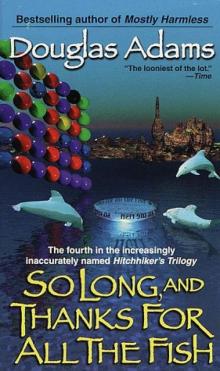 So Long, And Thanks For All The Fish
So Long, And Thanks For All The Fish The Long Dark Tea-Time of the Soul
The Long Dark Tea-Time of the Soul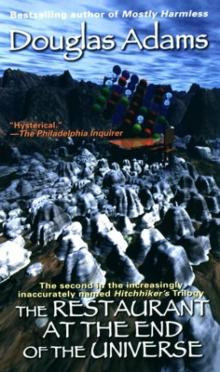 The Restaurant at the End of the Universe
The Restaurant at the End of the Universe Mostly Harmless
Mostly Harmless The Meaning of Liff
The Meaning of Liff Shada
Shada Mostly Harmless tuhgttg-5
Mostly Harmless tuhgttg-5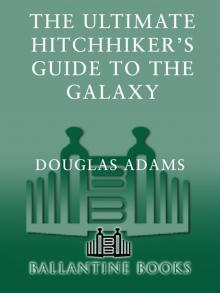 The Ultimate Hitchhiker's Guide to the Galaxy
The Ultimate Hitchhiker's Guide to the Galaxy The Hitchhiker's Guide to the Galaxy Further Radio Scripts
The Hitchhiker's Guide to the Galaxy Further Radio Scripts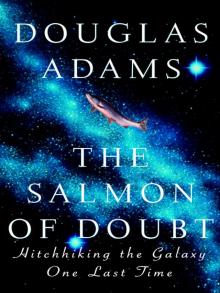 The Salmon of Doubt
The Salmon of Doubt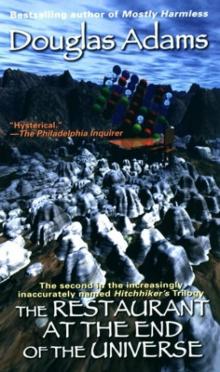 The Restaurant at the End of the Universe tuhgttg-2
The Restaurant at the End of the Universe tuhgttg-2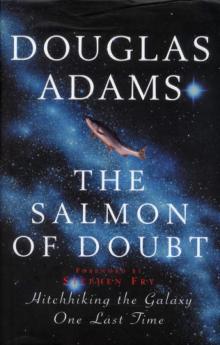 The Salmon of Doubt: Hitchhiking the Galaxy One Last Time dg-3
The Salmon of Doubt: Hitchhiking the Galaxy One Last Time dg-3 The Hitchhiker's Guide to the Galaxy Original Radio Scripts
The Hitchhiker's Guide to the Galaxy Original Radio Scripts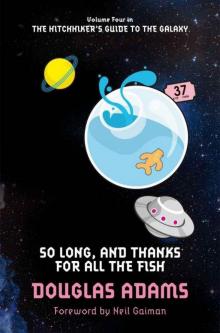 Volume 4 - So Long, And Thanks For All The Fish
Volume 4 - So Long, And Thanks For All The Fish Young Zaphod Plays It Safe
Young Zaphod Plays It Safe City of Death
City of Death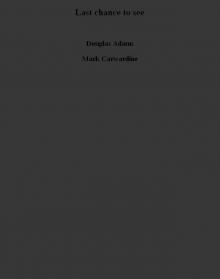 Last chance to see
Last chance to see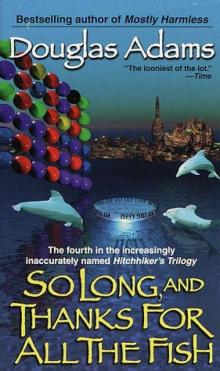 So Long, And Thanks For All The Fish tuhgttg-4
So Long, And Thanks For All The Fish tuhgttg-4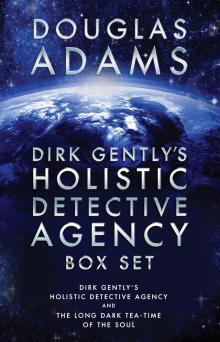 Dirk Gently's Holistic Detective Agency Box Set
Dirk Gently's Holistic Detective Agency Box Set The Hitchhiker’s Guide to the Galaxy tuhgttg-1
The Hitchhiker’s Guide to the Galaxy tuhgttg-1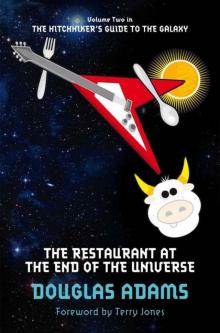 Volume 2 - The Restaurant At The End Of The Universe
Volume 2 - The Restaurant At The End Of The Universe Volume 3 - Life, The Universe And Everything
Volume 3 - Life, The Universe And Everything HHGTTG - The Lost Chapters
HHGTTG - The Lost Chapters